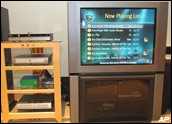
Microsoft has unveiled an updated beta release of its Silverlight multimedia publishing software. Chairman Bill Gates announced the debut of Silverlight 2 beta 2 at Microsoft’s TechEd conference in Orlando on Tuesday.
The utility, to be made available for public download by the end of the week, lets developers write Web-based applications using Microsoft’s .Net Framework. The company hopes the new beta’s added functionality will be another step toward luring programmers away from the long-dominant Adobe Flash software suite.
The company timed the release of two related programs to accompany the beta: Expression Blend 2.5 Preview and Silverlight Tools beta 2 for Visual Studio 2008.
“When I think back on the early days of development when we were all programming in DOS, and then take a look at what we can do now with technologies like the .Net Framework, it simply amazes me how far we’ve come,” Gates said during what he called his final keynote address as a full-time Microsoft employee.
A Long Battle
Microsoft may have come far, but it still has a long way to go to overtake Adobe in the world of interactive media. The new Silverlight 2 beta 2 fights hard, though: In conjunction with the.Net support introduced in the previous beta, the new release will have a dozen added controls, as well as improvements to networking and data-handling, WPF compatibility, and error-handling.
“It adds quite a lot,” said self-proclaimed Silverlight geek and Microsoft Senior Program Manager Jesse Liberty.
“We’ve gone from roughly two dozen to roughly three dozen tools in the toolbox,” he told TechNewsWorld. “From a working programmer’s viewpoint, the most noticeable change is in the way templates work and the ease of creating templates,” he said, “[and] the way that Expression Blend and Visual Studio together allow you to take control over the look and feel of objects in your application.”
Other noteworthy additions, according to Liberty, include the addition of scroll bars in text boxes, new cross-domain support, improved support for threading, and the implementation of an XML-based file format for Zoom — something he says will make the program a “much more prominent aspect of building Silverlight applications.”
Conversion Questions
The question that remains, of course, is whether the improvements are enough to convince veteran Flash users to make the switch. Microsoft remains confident, touting its deal with NBC to build a Silverlight-based Web site for the upcoming 2008 Olympics Games in Beijing. Liberty agrees.
“It’s big enough for me to give up 12 very happy years as an independent consultant and join Microsoft to work on it,” he told TechNewsWorld. “I think we have the much stronger story to tell.”
Not everyone is equally excited, though. Devoted Adobe users like Noel Green, creative director of Park East, is one of many with no plans to leave Flash behind.
“I’m not interested in it at all. I feel like it’s a Coke and Pepsi thing, and Pepsi has to do so much more advertising to sell what Coke was already selling,” he told TechNewsWorld.
“Flash just works,” Green added, citing its ability to function flawlessly on any computer and deliver a consistent display across various browser platforms.
Even an unswayable Silverlight supporter like Liberty knows Microsoft has a tough task in convincing veteran designers to change their minds.
“Will they put down their tools, walk away from their desks, and say, ‘Let’s go to Silverlight?'” he asked. “I know we have the best developer tools on the planet, [but] we would have to really show a tremendous value proposition to them.”
The full Silverlight release is expected later this year.




















































